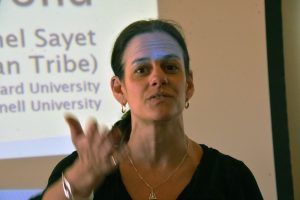Introduction to Environmental Studies/ENVS197 examines the technical and social causes of environmental degradation at local and global scales, along with the potential for developing policies and philosophies that are the basis of a sustainable society. This semester Dr. Helen Poulos, adjunct assistant professor of environmental studies, is teaching the course. Poulos is a plant ecologist who examines the influences of natural and anthropogenic disturbances on local-, landscape-, and regional-scale plant distribution patterns. She recently received a $300K research grant from NASA.

What are the class components of ENVS197 and how do those components tie-in with the COE’s focus on interdisciplinary study?
Helen Poulos (HP): The course is an intro/survey course, so we cover topics spanning the sciences, humanities, and social sciences. The idea is to cover the breadth of the field of study. The final project, however, is designed as a way for students to dive deeper into one environmental issue that really interests them. The final project options this semester include working with Wesleyan Physical Plant and Forklift Danceworks, making an artist book, or writing a Green Fund proposal. All three options are designed to provide students with unique opportunities to engage with environmental issues through a particular lens. For the Physical Plant project, students shadow Physical Pant workers for three hours each week and have biweekly group meetings with my course assistant, Tamara Rivera ‘21 and Gretechen LaMotte ’18 of Forklift Danceworks (via Skype). For the artist book project, students workshop their projects with Suzy Taraba from Special Collections and participate in two bookbinding and printmaking workshops with Alexander Osborne, visiting assistant professor of art. I also lead two workshops on grant writing for students who select the Green Fund proposal option.
- View photos from fall 2019 ENVS197 art book presentation
- View photos from fall 2019 ENVS197 performance with Physical Plant
How have the types of students who enroll in ENVS197 changed since you began teaching the class?
HP: This is the fourth time I’ve taught the class, and students are equally as passionate about the environment each time I teach it. The main change that I’ve seen is an increase in the number of women and students of color in the class. For example, the Forklift Danceworks final project is all women this year! Pretty cool. One thing that I’ve done on my end in teaching the course is to embed concepts of race, gender, class, and power (environmental justice) throughout the course content. I think that this is important not only to engage with the growing diversity of students who take the class, but also for all students to understand how environmental justice violations lie at the core of many of our environmental problems today. These problems are complex, and ignoring race, gender, power, and class will not get us to a place were we can tackle them.
What’s your favorite aspect of teaching an introductory-level course?
HP: My favorite thing about this class is getting to engage with first-years and sophomores. It’s so exciting to interact with students who are just beginning their college careers. They’re energized and ready to engage. They want to learn about the environment and the human-environment relationship. That makes me want to be a great teacher, and it makes me want to get to know each of my students, individually. It’s hard in a 52-person class, but I try to get to know each of them personally.
Why are you a faculty member in the College of the Environment?
HP: I love nature, and while I’m trained as a natural scientist, my experiences as a professor at the COE have taught me the importance of interdisciplinarity in environmental problem solving. We are confronting some of the most complicated and scary environmental issues in history. Climate change, for example, is something that affects us all, as a global community. If we are going to keep warming below 2 degrees centigrade, we’re going to have to confront climate change from all angles. That’s the perspective of the COE: interdisciplinarity.